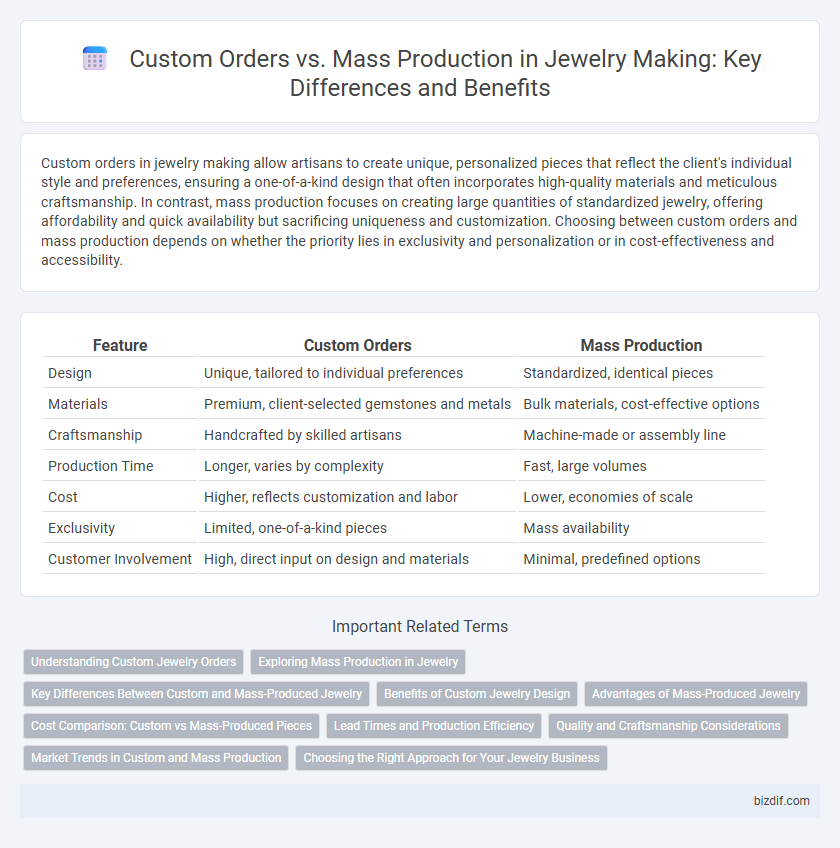Custom orders in jewelry making allow artisans to create unique, personalized pieces that reflect the client's individual style and preferences, ensuring a one-of-a-kind design that often incorporates high-quality materials and meticulous craftsmanship. In contrast, mass production focuses on creating large quantities of standardized jewelry, offering affordability and quick availability but sacrificing uniqueness and customization. Choosing between custom orders and mass production depends on whether the priority lies in exclusivity and personalization or in cost-effectiveness and accessibility.
Table of Comparison
| Feature | Custom Orders | Mass Production |
|---|---|---|
| Design | Unique, tailored to individual preferences | Standardized, identical pieces |
| Materials | Premium, client-selected gemstones and metals | Bulk materials, cost-effective options |
| Craftsmanship | Handcrafted by skilled artisans | Machine-made or assembly line |
| Production Time | Longer, varies by complexity | Fast, large volumes |
| Cost | Higher, reflects customization and labor | Lower, economies of scale |
| Exclusivity | Limited, one-of-a-kind pieces | Mass availability |
| Customer Involvement | High, direct input on design and materials | Minimal, predefined options |
Understanding Custom Jewelry Orders
Custom jewelry orders prioritize personalized designs tailored to individual preferences, offering unique craftsmanship and attention to detail. Each piece is created to reflect specific style, materials, and measurements requested by the customer, ensuring exclusivity. Unlike mass production, custom orders involve direct collaboration between the jeweler and client, resulting in one-of-a-kind items with higher perceived value and emotional significance.
Exploring Mass Production in Jewelry
Mass production in jewelry enables the creation of consistent designs at scale, reducing costs and accelerating delivery times. Advanced techniques such as 3D printing and automated casting streamline manufacturing, ensuring uniform quality across large batches. This approach meets high consumer demand while allowing brands to maintain competitive pricing and expand market reach.
Key Differences Between Custom and Mass-Produced Jewelry
Custom jewelry involves handcrafted, unique pieces tailored to individual preferences, emphasizing personalized design, high-quality materials, and intricate craftsmanship. Mass-produced jewelry is manufactured in large quantities using automated processes, prioritizing cost-efficiency, uniformity, and faster production timelines. The key differences lie in customization level, production scale, material quality, and the exclusivity of each piece.
Benefits of Custom Jewelry Design
Custom jewelry design offers unparalleled personalization, allowing artisans to create unique pieces that reflect individual styles and meaningful stories. This approach ensures higher craftsmanship quality and the use of specific materials tailored to client preferences, enhancing both aesthetic value and emotional significance. Unlike mass production, custom orders support sustainable practices by reducing waste and promoting exclusive, one-of-a-kind artworks.
Advantages of Mass-Produced Jewelry
Mass-produced jewelry offers consistent quality and affordable pricing due to economies of scale, making luxury designs accessible to a broader audience. The streamlined manufacturing process ensures faster production times and availability, meeting high demand without sacrificing precision. Standardized designs also facilitate widespread distribution through various retail channels, enhancing customer convenience and choice.
Cost Comparison: Custom vs Mass-Produced Pieces
Custom jewelry orders typically incur higher costs due to personalized design, handcrafted detailing, and premium materials tailored to individual specifications. Mass-produced jewelry benefits from economies of scale, significantly reducing manufacturing expenses and retail pricing through standardized designs and bulk material procurement. Consumers choosing custom pieces invest more upfront for exclusivity, craftsmanship, and customization, whereas mass-produced items offer affordability and accessibility at the expense of uniqueness.
Lead Times and Production Efficiency
Custom orders in jewelry making require longer lead times due to personalized design processes and handcrafting, often extending from weeks to months. Mass production enhances production efficiency by utilizing standardized molds and automated techniques, resulting in shorter lead times of days to weeks. Balancing customized artistry with streamlined workflows determines the optimal approach for meeting client demands efficiently.
Quality and Craftsmanship Considerations
Custom orders in jewelry making prioritize exceptional quality and intricate craftsmanship by allowing artisans to focus on detailed designs tailored to individual preferences, resulting in unique pieces with superior materials and finishes. Mass production often compromises on these elements to achieve higher output and lower costs, leading to standardized designs and less attention to fine detailing. The choice between custom orders and mass production directly impacts the durability, artistry, and overall value of the finished jewelry.
Market Trends in Custom and Mass Production
Market trends in jewelry making reveal a rising demand for custom orders as consumers increasingly seek personalized, unique pieces reflecting individual style and sentiment. Mass production still dominates the market due to its cost efficiency and wide availability but faces competition from bespoke services enabled by advancements in CAD design and 3D printing technology. Brands leveraging customization platforms experience higher customer engagement and loyalty, signaling a shift towards personalized jewelry as a significant growth driver.
Choosing the Right Approach for Your Jewelry Business
Custom orders in jewelry making allow for personalized designs that cater to individual customer preferences, enhancing brand uniqueness and customer loyalty. Mass production offers cost efficiency and faster turnaround times, suitable for businesses targeting a broader market with standard designs. Selecting the right approach depends on balancing quality, scalability, and customer demand to optimize profitability and brand identity.
Custom Orders vs Mass Production Infographic

 bizdif.com
bizdif.com